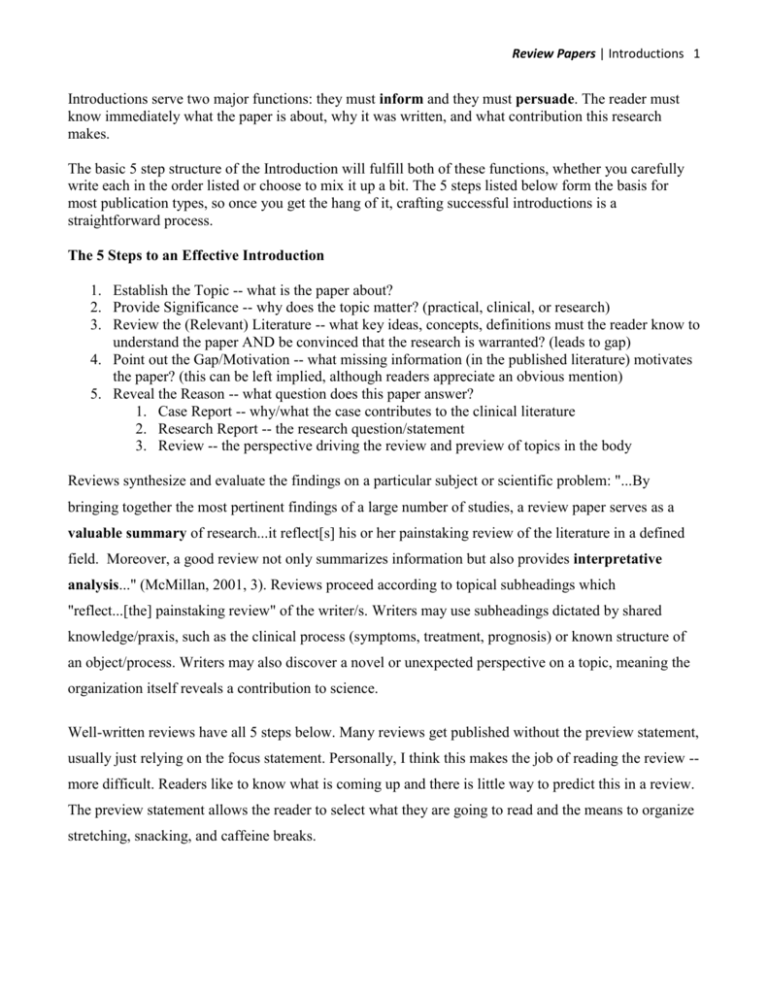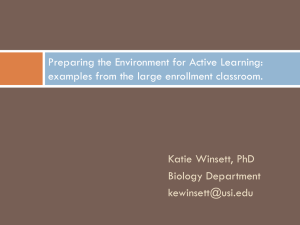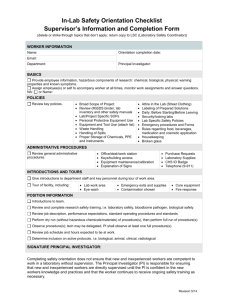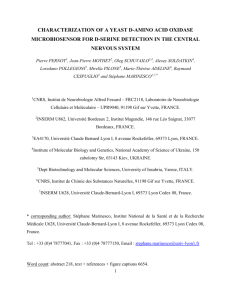Structure Outline -- Intro
advertisement

Review Papers | Introductions 1 Introductions serve two major functions: they must inform and they must persuade. The reader must know immediately what the paper is about, why it was written, and what contribution this research makes. The basic 5 step structure of the Introduction will fulfill both of these functions, whether you carefully write each in the order listed or choose to mix it up a bit. The 5 steps listed below form the basis for most publication types, so once you get the hang of it, crafting successful introductions is a straightforward process. The 5 Steps to an Effective Introduction 1. Establish the Topic -- what is the paper about? 2. Provide Significance -- why does the topic matter? (practical, clinical, or research) 3. Review the (Relevant) Literature -- what key ideas, concepts, definitions must the reader know to understand the paper AND be convinced that the research is warranted? (leads to gap) 4. Point out the Gap/Motivation -- what missing information (in the published literature) motivates the paper? (this can be left implied, although readers appreciate an obvious mention) 5. Reveal the Reason -- what question does this paper answer? 1. Case Report -- why/what the case contributes to the clinical literature 2. Research Report -- the research question/statement 3. Review -- the perspective driving the review and preview of topics in the body Reviews synthesize and evaluate the findings on a particular subject or scientific problem: "...By bringing together the most pertinent findings of a large number of studies, a review paper serves as a valuable summary of research...it reflect[s] his or her painstaking review of the literature in a defined field. Moreover, a good review not only summarizes information but also provides interpretative analysis..." (McMillan, 2001, 3). Reviews proceed according to topical subheadings which "reflect...[the] painstaking review" of the writer/s. Writers may use subheadings dictated by shared knowledge/praxis, such as the clinical process (symptoms, treatment, prognosis) or known structure of an object/process. Writers may also discover a novel or unexpected perspective on a topic, meaning the organization itself reveals a contribution to science. Well-written reviews have all 5 steps below. Many reviews get published without the preview statement, usually just relying on the focus statement. Personally, I think this makes the job of reading the review -more difficult. Readers like to know what is coming up and there is little way to predict this in a review. The preview statement allows the reader to select what they are going to read and the means to organize stretching, snacking, and caffeine breaks. Review Papers | Introductions 2 1. #1: Association between Essential Tremor and Other Neurodegenerative Diseases: What Is the Epidemiological Evidence? www.ncbi.nlm.nih.gov/pubmed/21757958 Essential tremor (ET), whose core clinical feature is a progressive kinetic tremor of the arms, is one of the most common neurological diseases [1]. There are 28 population-based prevalence studies [2] and, based on these studies, it is clear that the crude prevalence (0.4%, all ages) rises markedly with age, reaching values of 6.3% among those ≥ 65 years of age and 21.7% amongst those ≥ 95 years [2]. Previously viewed as monosymptomatic and benign [3], ET has been increasingly recognized to be a syndrome characterized by a broader set of motor features (e.g. several types of tremor, gait abnormalities) as well as nonmotor features [4–6] . Topic + Significance (Practical) Significance --Practical Lit review begins Clinicians have long observed that there seems to be a tendency for ET patients to develop incident Parkinson’s disease (PD), raising questions about a link between these two neurological diseases [7–12]. In addition, given the advanced age of many ET cases, the co-occurrence of Alzheimer’s disease (AD) has been observed as well, and recent studies have suggested a greater cooccurrence of the two conditions than might be expected based on chance alone [13, 14]. Along with these observations, recent evidence suggests that ET is a neurodegenerative condition [15– 17], and investigators have sought to determine whether there are shared mechanisms underlying this group of disorders [12, 18] . Lit review continues and motivation is clarified Our aim in this review was to evaluate the epidemiological literature on the association between ET and other neurodegenerative conditions, focusing specifically on PD and AD. To our knowledge, there has been no published review of the epidemiological evidence. Overview – “focus” is stated first – preview is implied Review Papers | Introductions 3 #2: Heme Oxygenase: A Font of Multiple Messengers / http://www.nature.com/npp/journal/v25/n3/full/1395718a.html 2. 3. 4. 5. Neurotransmitters and related messenger molecules abound in the 6. brain with numbers ranging between 50 and 100 depending on who 7. is doing the counting. Their chemical structures vary from 8. peptides and large proteins to metal ions such as zinc and the 9. gases nitric oxide (NO) and carbon monoxide (CO). diatomic Most 10. are formed by enzymatic processing although there are 11. notable exceptions. The neurotransmitter pool of zinc comes from a zinc12. transporter that concentrates the metal into synaptic vesicles 13. together with glutamate. Neurotransmitter pools of amino acids 14. are probably sequestered largely by transporters although this is 15. not altogether clear. For the most part, neurotransmitter peptides 16. are not generated by selective enzymes but by generalized 17. peptide-processing enzyme systems. Highly selective 18. neurotransmitter forming enzymes exist for the biogenic amines; 19. for D-serine, which is formed by serine racemase that converts L20. serine to D-serine (Wolosker et al. 1999, 2000); for NO, generated 21. from 22. arginine by NO synthase (NOS); and for CO, formed from heme23. by heme oxygenase (HO). In most cases the biosynthetic enzyme or series of enzymes yield a single end product. For instance, tryptophan hydroxylase coupled with aromatic amino acid decarboxylase is solely concerned with forming serotonin, while tyrosine hydroxylase, aromatic amino acid decarboxylase, and dopamine beta-hydroxylase together generate norepinephrine. The focus of this essay is a notable exception. Heme oxygenase gives rise to three discrete products, CO, ferrous iron and biliverdin-bilirubin. Only recently has there been an appreciation that all three of these products have important physiologic roles which may be complementary. Topic – general realm of science that paper is about + suggestion of research significance (“50-100…”) Lit Review leading to Gap/Motivation for paper From “In most cases” to “notable exception” is motivation for paper Overview – focus and preview are switched in order: preview is “CO, ferrous iron, biliverdin-bilirubin” and focus is “physiologic roles which may be complementary”. Review Papers | Introductions 4 Structure Your Review Introduction 1. What is topic this review is about? This should be a very specific first sentence. Do not write introductory fluff such as “Science has always been interested in ageing. To understand ageing better, neural connections…”. If you have to write this to get started, that’s okay. I can edit it out! 2. How is this topic of general importance/relevance? Expressed in terms of: practical (e,g, % affected or experience from patient’s perspective) clinical (having to do with the pathology itself, often diagnostic or treatment related) research (relevance to new discovery, researcher-oriented) 3. What does the reader need to know? This is the literature review -- a brief background framing the review, usually just a few sentences providing key definitions or concepts Most of the work happens in the body – these introductions can be very short. Longer introductions are seen when the writer must assure that the reader knows more in order to follow the body of the review 4. What is missing that motivates this work? 5. What is the perspective on the literature you are using? What are the body sections of the paper? Focus -- the critical perspective the reviewer is using to organize the body, e.g, only examining claims of efficacy, only examining pathophysiology, etc. Preview -- roadmap of body sections so that reader knows what's coming up – use full or shortened versions of the actual body subheadings in the paper







